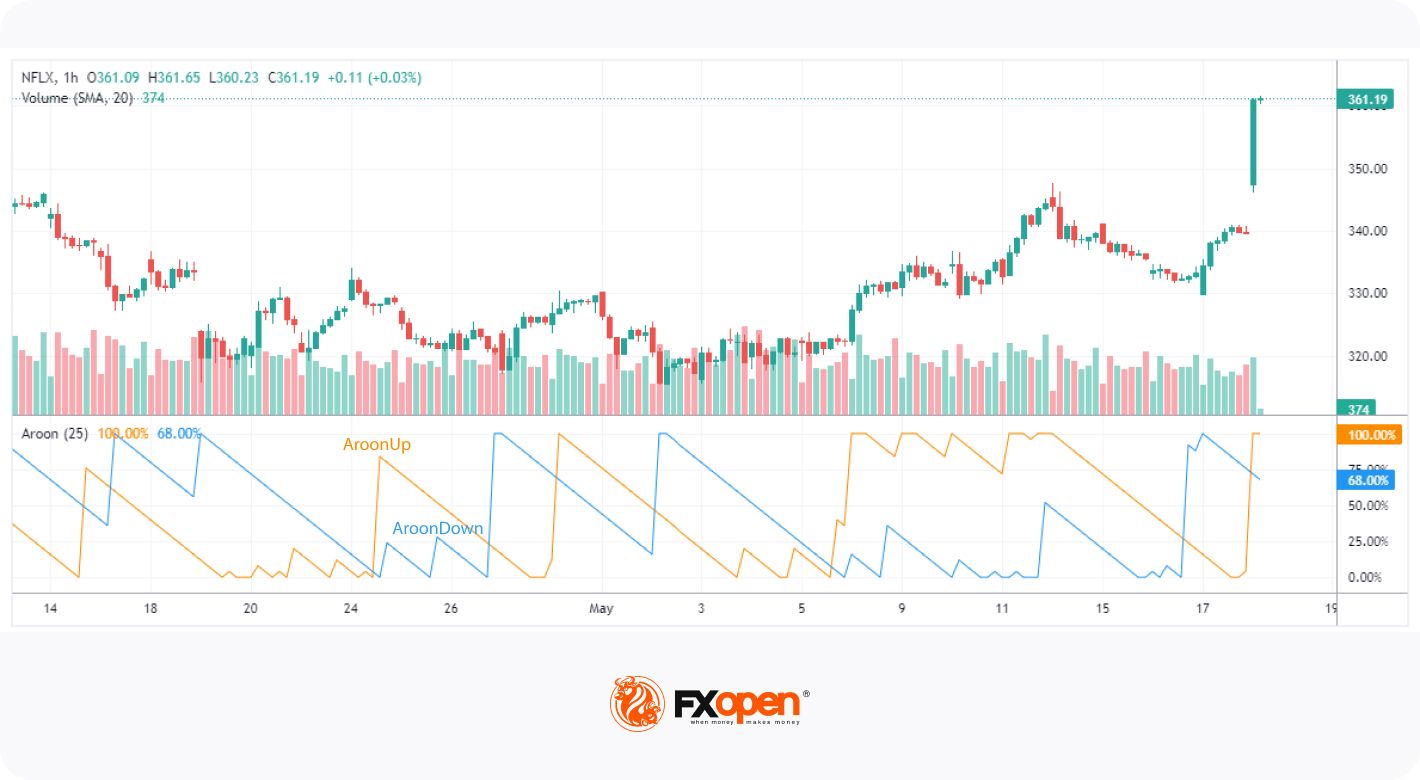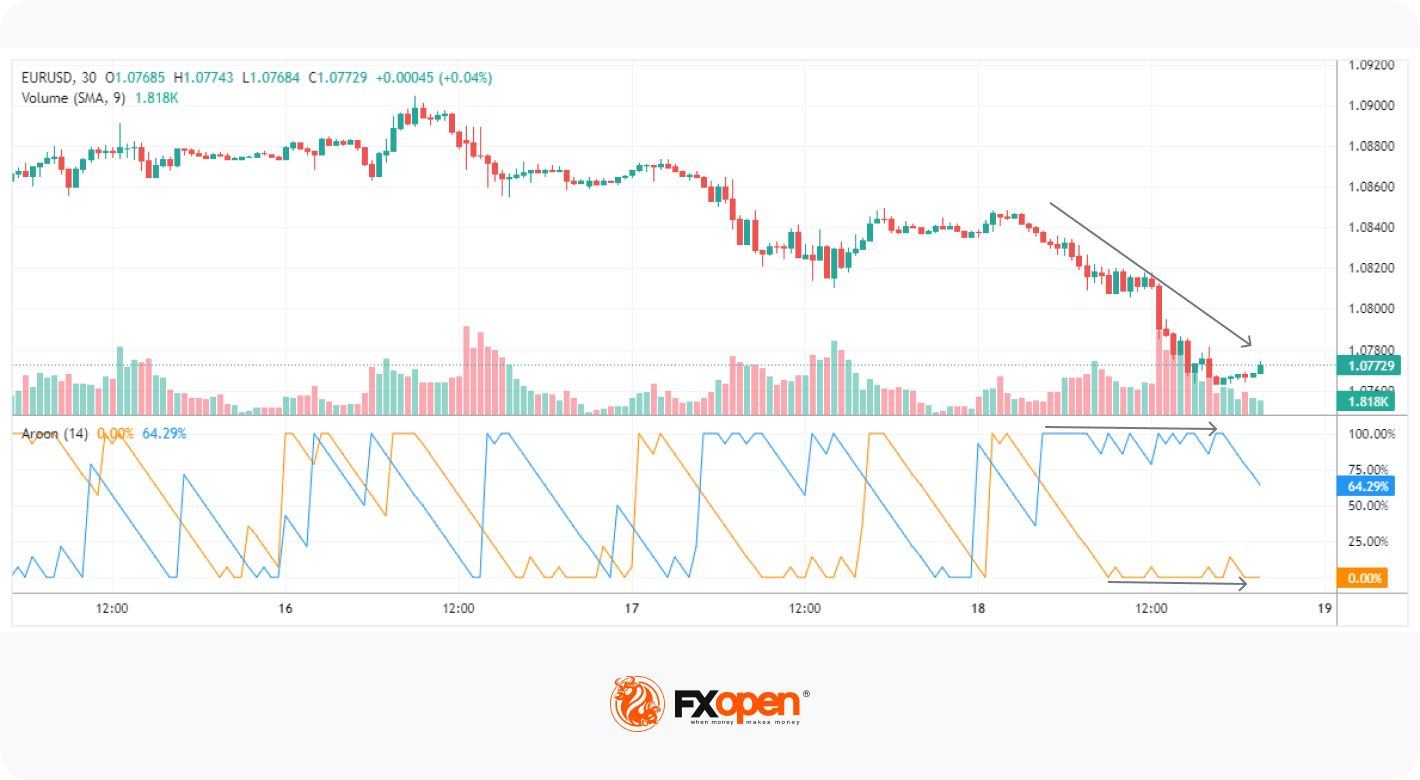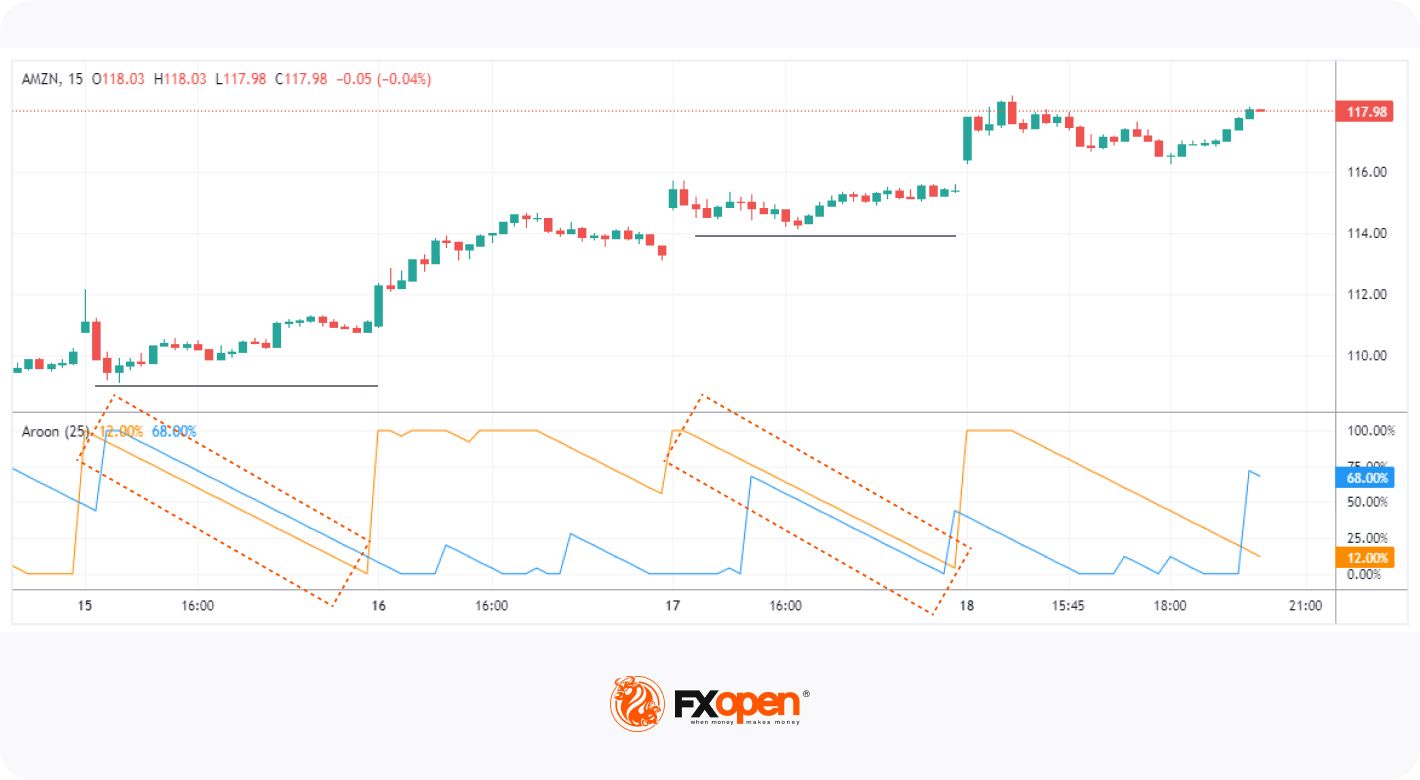FXOpen

The Aroon indicator is one of several technical analysis indicators that traders use to identify the direction of trends and establish when they are set to reverse.
In this FXOpen article, we describe how to use the Aroon indicator to buy and sell stocks as well as other assets and explain why traders use it in combination with other technical analysis tools to help direct your trading strategies.
What Is the Aroon Indicator?
The Aroon indicator was created in 1995 by Tushar Chande, a technical analyst who has created several popular trading indicators. It features dual lines: The "Aroon Up" denotes the strength of an uptrend, while the "Aroon Down" measures the strength of a decline.
Is the Aroon indicator leading or lagging? It is lagging as it measures how much time has passed between market highs and lows over a given period, based on the idea that assets in a strong bullish trend will regularly record new highs, while those in decline will regularly trade at new lows. Traders utilise this to determine if an asset is trending, trading within a range, or starting a new trend. It helps them to gauge the strength of the movement and anticipate when prices will change direction.
Aroon Indicator Formula Explained
The Aroon indicator formula comprises two separate calculations.
The formula for the Aroon Up line = [(Specified Period – Periods Since the Highest Value Within Period) / Specified Period] x 100%.
The formula for the Aroon Down line = [(Specified Period – Periods Since the Lowest Value Within Period) / Specified Period] x 100%.
The Aroon indicator is explained as a tool to evaluate the highest and lowest values within a specified timeframe. If the highest value occurs in the current candlestick, the up value is set to 100, indicating a new peak. If not, it returns a percentage value indicating the time elapsed since the last peak. Conversely, if the lowest value occurs in the current bar, the down value is 100, indicating a new low. It otherwise returns a percentage value that shows the time since the last low within the timeframe.
Best Setting for the Aroon Indicator
Using a short timeframe often makes it difficult to interpret this indicator. Chande recommends the best setting for the calculation is to measure prices over 25 periods, tracking when the last top and bottom occurred. The TickTrader platform does this for you, displaying the Aroon Up and Aroon Down indicators below the price data on a chart.

The two lines range between 0 and 100. When measuring 25-day periods, a number above 50 indicates that the high or low was hit within the last 12.5 days, while numbers below 50 show that the high or low was seen within the previous 12.5 days. Below, we look at how to read the Aroon indicator.
How to Implement the Aroon Indicator Into Your Strategy
There are four main ways you might utilise an Aroon indicator on a chart to analyse price action. The results are relatively easy to interpret.
Identify Prevailing Trends
The most common way to use it is to determine the direction of the market. If Aroon Up is above the 50 level and the Aroon Down below 50, the trend is bullish, and it is more likely that the market will surge to new highs than lows. You could take this as a signal to enter or hold a long position. Conversely, if the down value is above 50 and the up value is below 50, as on the chart below, the trend is bearish, and you could opt to go short.

Identify Potential Trend Changes
Crossovers of the two lines often indicate that the market is changing direction. When Aroon Up crosses above Aroon Down, the market may be starting a new bullish trend. It is considered to be underway when the Aroon Up line reaches 100 and is confirmed if it remains between 70 and 100, with the Aroon Down between 0 and 30.
A bearish turn could be emerging if Aroon Down crosses over the Aroon Up line and reaches 100. If it remains between 70 and 100 while the Aroon Up holds between 0 and 30, the bearish move is confirmed.
You could utilise this as a signal to go long once the Aroon Up crosses above the Aroon Down and go short once the Aroon Down crosses above the Aroon Up.
Note that sometimes the lines will break above 50 before crossing over each other.
Assess Trend Strength
Values between 70 and 100 not only confirm a trend is underway but also point to its strength. The closer to 100 the reading, the stronger the trend. Values closer to zero indicate that the momentum is weak. Understanding the strength of the move can help you decide whether to enter, exit or remain in a position.
Identify Consolidation Periods
The lines moving in parallel suggest that the market is consolidating within a range, as shown in the chart below. If both are below 50, no new highs or new lows have been set in the last 12.5 periods. Traders can take the opportunity to monitor the market and look for the next crossover in the Aroon Up and Down indicator lines to signal in which direction the asset will move to break out of the range.

How to Combine Aroon with Other Indicators
As technical indicators sometimes provide false signals, traders try to combine multiple analytical tools to confirm trends, reversals, and momentum before taking a position. Here’s how to use the Aroon Up and Down indicator with various other tools to help direct your trading.
Moving Averages
When a moving average points to an upward movement alongside the Aroon lines, it might be a bullish signal to enter a long trade. And when both tools are bearish, you could choose to go short.
The death cross – a short-term moving average falling below its longer-term moving average, signalling a decline in a price – and the golden cross, in reverse, may be combined with Aroon crossovers to identify changes in direction. You might opt to check higher timeframes for the Aroon chart to filter out noise.
Relative Strength Index (RSI)
Combining Aroon Up and Aroon Down with the RSI often provides a strong indication of a reversal. The RSI and spikes in the Aroon help you to identify overbought or oversold conditions. When the RSI is in an overbought or oversold zone, and the Aroon moves above 50, it may provide a potential entry point for a trade.
Donchian Channels
The Donchian Channels identify potential breakouts and reversals, and you can refer to the Aroon lines plus the 100-period moving average for confirmation. If the price rises within the upper Donchian channel above the 100-period moving average with the Aroon pointing to a strong uptrend, you could take a long position, whereas confirmation of a downtrend could prompt you to go short.
Parabolic SAR
If the Parabolic SAR indicates that the market has bottomed, suggesting a buy trade, you could check the Aroon to confirm that the price has reached the reversal stage into an uptrend. You could initiate a long position with a stop loss placed below the first Parabolic SAR dot or using Fibonacci intervals. Conversely, if the Aroon suggests the asset could reverse into a decline, you could confirm the signal with the Parabolic SAR to initiate a short trade.
Aroon Indicator: Advantages and Disadvantages
There are several advantages to using the indicator, including that:
- It’s simple to read, making it easy to analyse and suitable for beginners
- It effectively signals changes in direction
- It provides valuable insights when used in conjunction with other technical indicators
- It allows the use of customisable time periods to fit your needs
While it is useful, there are also disadvantages, including:
- As a lagging indicator, it misses out on trading opportunities at the start of a trend
- It measures the time between new highs or new lows but not how much the price has changed
- Sometimes, it provides false signals in choppy markets as the rapid price changes cause it to whipsaw
- Sometimes, it gives late signals when the asset has already moved and is preparing to retrace, especially when you apply the Aroon indicator without other indicators
Conclusion
The Aroon technical indicator is a simple-to-use technical indicator comprising two lines that help you to determine the direction and strength of asset price trends. It is most effective when used on charts in conjunction with other technical indicators and patterns to provide confirmation before taking a position. You can open an FXOpen account to practise using the Aroon indicator and other tools of technical analysis.
This article represents the opinion of the Companies operating under the FXOpen brand only. It is not to be construed as an offer, solicitation, or recommendation with respect to products and services provided by the Companies operating under the FXOpen brand, nor is it to be considered financial advice.
Stay ahead of the market!
Subscribe now to our mailing list and receive the latest market news and insights delivered directly to your inbox.








